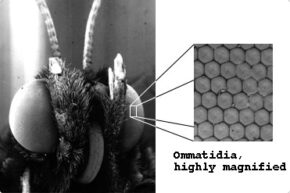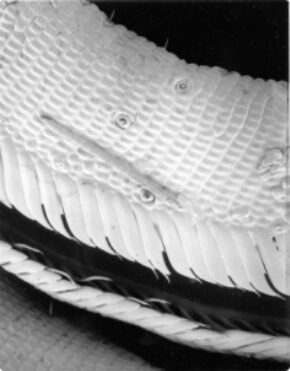Butterflies’ sensory systems help them locate food and mates, avoid predators, and choose appropriate host plants for their eggs. Their senses may be divided into four basic categories: touch, hearing, sight, and taste. The last two categories are usually the most well-developed systems in butterflies. The information below introduces important organs associated with sensory systems at different life stages and explains how a butterfly uses its senses to navigate through its world.
Butterfly sensory systems are very different from humans. For example, they can see ultraviolet light and hear ultrasound. These differences can make it hard to study butterfly senses and means that butterflies likely use their senses in many ways we do not yet understand.
Touch

Touch is important in different ways during the larval and adult stages.Both stages sense touch through hairs that extend through sockets in the exoskeleton. These hairs (tactile setae) are attached to nerve cells which relay information about the hairs’ movement to the butterfly.
In larvae, tactile setae are scattered fairly evenly over the whole body. You can see these setae on monarch larvae with a simple magnifying lens or under a microscope. Larvae have a variety of responses to touch, and these responses may change over time. Larvae often curl up into a ball when lightly touched.
Adults have tactile setae on almost all their body parts, and these setae play an important role in helping the butterfly sense the relative position of many body parts. This is especially important for flight, and there are several collections of specialized setae and nerves that help the adult sense wind, gravity, and the position of head, body, wings, legs, antennae, and other body parts. Setae on the adult monarch’s antennae sense both touch and smell.
Hearing

In general, butterflies have poor hearing. Larvae perceive sound through
tactile setae, but they mainly respond to sudden noises. For example, monarch larvae often rear up if you clap loudly near them. This reaction is called a startle response, a behavior that probably evolved to protect the larvae from predators who make noise.
If you clap repeatedly, the caterpillars get used to the noise and stop responding—a phenomenon of learning called habituation. Habituation occurs throughout the animal kingdom, even in humans. For example, people who live in cities often stop noticing the noise of traffic until they go out into the country and notice its absence again.
Adult butterflies often sense sound through veins in their wings, but scientists have only studied this in a limited number of species. A few species of moths and butterflies (not monarchs) make sound by rubbing or clicking together parts of their bodies, such as wings or legs. In some species this may be a means of communication between individuals and can play an important role in finding mates. In other species it seems to serve as a way to scare off predators such as birds. We do not know how many species of butterflies and moths use sound because humans often can’t hear the noises they produce.
Sight

Butterflies see very differently during different stages of their lives. Larval vision is limited and poor. They see with 12 ocelli, which have only a few cells each (compared to the thousands of cells associated with adult insect eyes or human eyes). However, larvae still see the same range of light as adult butterflies— from red all the way through ultraviolet.
Adults see through compound eyes made up of thousands of ommatidia. Each ommatidium gathers light and processes visual information through its own lens and nerve system. The small plastic “bug eyes” available in many science, toy and photography stores can give students an idea of how the world looks through a compound eye. Compound eyes give butterflies an excellent perception of color and motion in a wide range; butterflies can see up, down, forward, backward, and to the sides at the same time. However, they are not very good at judging distance or perceiving patterns, and the images are not united into one continuous picture. Butterflies see the world as a series of still photos rather than a movie.
Butterflies can also perceive polarized light, or light waves that move in only one direction, and butterflies can sense that direction. Bees use their perception of polarized light to navigate to and from their hives. Some scientists have suggested that butterflies may use polarized light to move around their habitat and to migrate.
Taste and Smell

Butterflies get much of their information about the world through chemoreceptors scattered across their bodies. In butterflies, chemoreceptors are nerve cells that open onto the surface of the exoskeleton and react to the presence of different chemicals in the environment. They operate on a system similar to a lock and key. When a particular chemical runs into a chemoreceptor, it fits into a “lock” on the nerve. This sends a message to the
nerve cell telling the butterfly that it has encountered the chemical. For example, organs on the back of butterfly tarsi sense dissolved sugar. When dissolved sugar touches these chemoreceptors, the butterfly extends its proboscis to eat the nectar its tarsi have sensed. Humans also have chemoreceptors, which are concentrated on the tongue (tastebuds) and in the nose.

Adult butterflies sense most smells through their antennae, which are densely covered with chemoreceptors, especially on the clubs. In monarchs, chemoreceptors on the antennae sense the odor associated with nectar and feeding as well as special chemicals released by the male, called pheromones. In general, pheromones help males and females of the same species find each other to mate. Monarch males can produce pheromones, which they secrete through special glands on the wings. In contrast to their close relatives, however, monarchs do not require pheromones for successful mating. Scientists are still studying what role, if any, pheromones play in monarch mating rituals.
Female butterflies often have important chemoreceptors on their legs to help them find appropriate host plants for their eggs. These chemoreceptors are at the base of spines on the back of the legs, and they run up along the spine to its tip. Females drum their legs against the plant, which releases plant juices. The chemoreceptors along the spines tell the butterfly whether she is standing on the correct host plant. Monarch females test host plants with all six legs before laying eggs. They also probably have chemoreceptors on their ovipositor. All of the sensory information helps female monarchs find the correct host plant for their eggs, which is essential for the survival of their offspring.
SEM Photos Courtesy of Michelle Solensky

